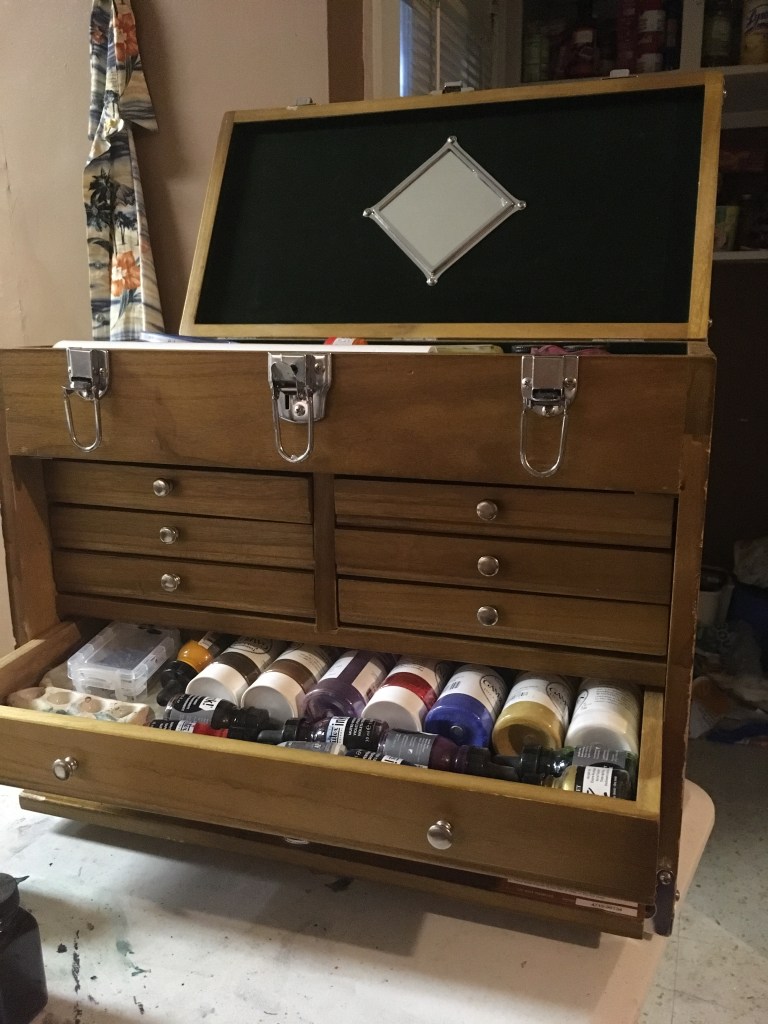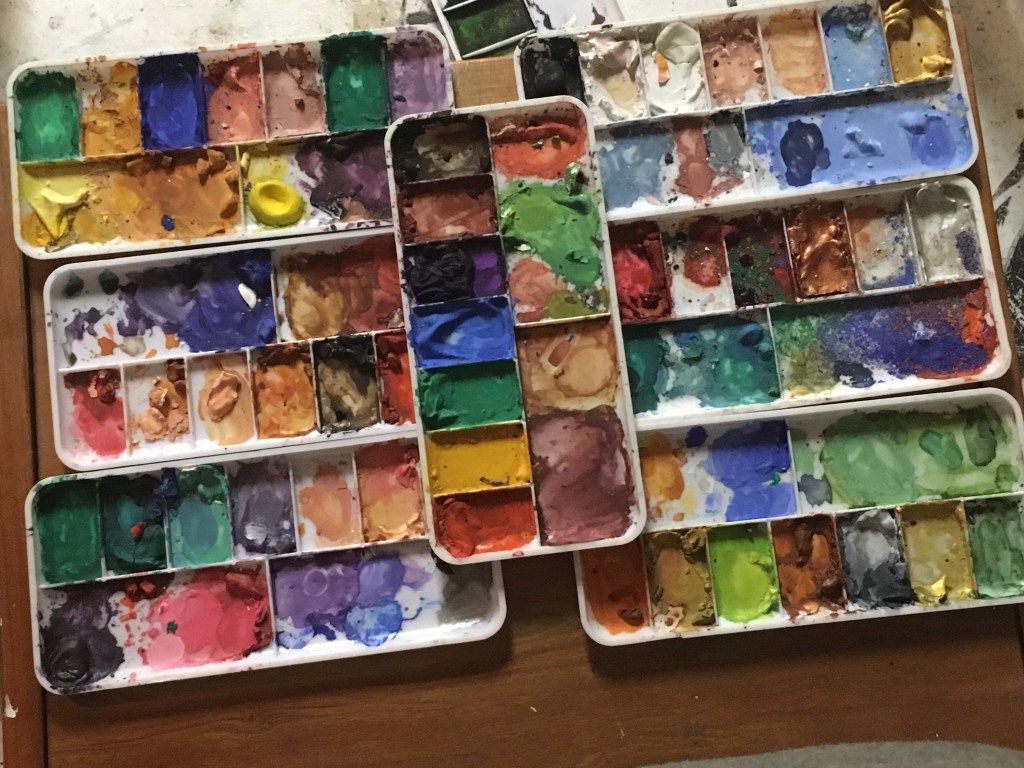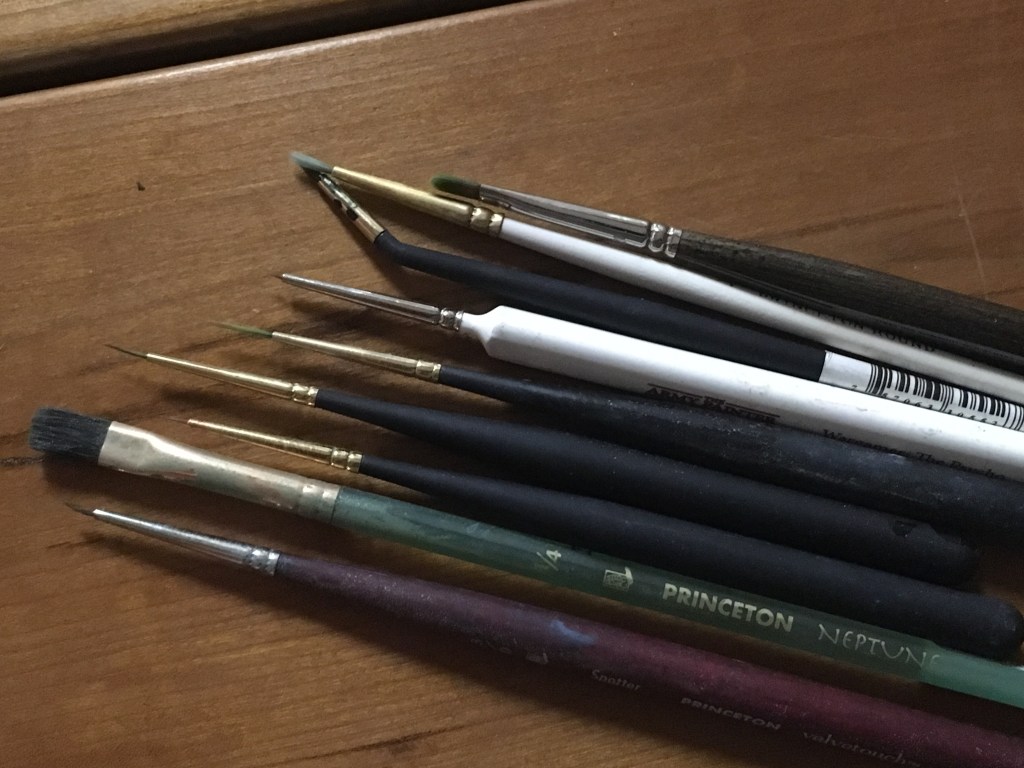A lot of people in the past few weeks in the SCA scribal-verse have been asking about how to get started as a scribe in the SCA. I can really only speak as a scribe in Calontir, but the basics of types of paint and other supplies is fairly universal. This blog post will serve as a start on how to get started, what supplies to consider buying first, and where you can get the most bang for your buck.
While calligraphy is a large portion of SCA scribal, I am primarily going to speak about purchasing illumination supplies. That said, if you are getting started in calligraphy, consider purchasing Harris’ The Calligrapher’s Bible. It isn’t entirely period, but it will help get you started on calligraphy.
The first place I recommend starting off for illumination supplies is in the paint section. As SCA scribal has a tendency to use gouache as the primary medium, sourcing this can be difficult, especially if you’re not entirely sure what to look for. Gouache is an opaque watercolour, similar in use to traditional transparent watercolour, but dries far more opaque and matte, much like an acrylic paint. Unlike acrylic paint, however, it is easily rewettable and reworkable. Gouache is also formulated similarly to paint used in period, and gives a similar look.
Back when I started doing scribal (over a decade ago!), I purchased a bunch of Royal Talens gouache tubes on clouseout that averaged anywhere from about $2-7 each, and remarkably, some of those tubes still have paint in them and are still good, even over a decade later. That said, I’ve had some difficulty finding Royal Talens gouache in my local stores, and as time has gone by, I’ve started upgrading to various other brands, including Winsor & Newton, Holbein, and my current favourite, M. Graham, but because gouache can be workable after it’s dried, I often don’t buy tubes that often; usually, if I’m buying paint, it’s because I’ve run out of an older colour and I can finally upgrade. Even then, M. Graham is still about $14 a 15 mL tube, and even when I’m painting a lot, it takes a while to go through that much paint.
The point is, you do not have to spend a lot of money to get started on paint. You do want a few basic colours, but you can get started using brands like Arteza or Reeves, or start, if you’ve done some other paint mediums before, with a few tubes to mix paint as you go.
At the very least, here’s a basic list of colours you need starting out. It is where the bulk of your investment is going.
Titanium white (I use this for doing whitework)
Zinc white (I use this one for mixing to make colours lighter)
Lamp black (I rarely use black, but it’s good to have for mixing into colours, but use it with care as it can overwhelm what you’re mixing in)
Sepia (I actually use this instead of black for lining. I also occasionally use this when I need a darker tone on a warm colour)
Ultramarine blue
Pyrrol Red (or a warm-toned red)
Azo Yellow (or a neutral-toned yellow)
Burnt Sienna (mix this with zinc white, and it’s a near perfect Caucasian skintone, but is also great for hair)
Yellow Ochre (it looks gross, but it’s one of those colours that works well for a lot of things)
Viridian (or another leafy-kind of blue-green; even though I mix colours well, medieval shades of green are sometimes hard to match)
If you live in a kingdom that has purple in their awards/heraldry (looking at you, Calontir and the East), it is also good to have a purple. I am fond of Holbein’s Iris, but play around and see what works for you.)
You might also want something to make your first scribal work pop a little, and in which case, that usually means metallics. I covered a lot of what metallics to use in The Great Gold Paint Review, but if you’re starting out, I definitely recommend something like a tube of Holbein gold pearl or even Kuretake’s Gansai Tambi Starry. The Gansai Tambi are a bit more expensive, but with a variety of golds to play with, it can give a bunch of variety. Holbein’s gold pearl is a workhorse, and it looks so gorgeous on finished scribal works.
The next thing you’ll need are brushes – this is where it can add up as well, but careful purchasing, and taking good care of your brushes, and you’ll be able to make your dollar stretch.
Starting off, I don’t recommend getting expensive Kolinsky sable brushes. They’re really nice brushes, but they’re expensive, and can be hard to take care of. That said, because gouache is a watercolour, you do want good watercolour brushes that will soak up water and paint. Princeton Velvetouch is my personal favourite, but even brushes made with Taklon fibres can still be useful. When I got started, I bought a set of mini watercolour brushes – and I still use them today because I took pretty good care of them (don’t leave them in water, clean them with brush soap, and take care to not press too hard on the bristles, and your brushes will last for a while).
Princeton Brushes do make a pack of watercolour brushes that is reasonably priced, and contains most of the brushes a starting scribe will use. You may, in time, want to pick up larger or smaller brushes (I have a deep abiding love of my 20/0 brushes), but starting off, having round brushes in 3/0, 2, and 4 sizes, and two flat brushes in sizes 2 and 6 are good. You may want to invest in a good pointy size 1 or 0 round, but that’s if you have the means to do so. If your brush comes with a plastic tube on it, keep the tube – it’ll help keep your brushes looking nice and will keep them from getting damaged while in storage.

Water cups! These are probably one of the cheapest items. Oui yoghurt jars are great for this, but if you want something a bit more transportable, Faber-Castell makes a small collapsible water pot that’s great for taking to events.
Of course, your paints will need to go on a palette of some kind. I recommend plastic for starting out, and you can find any number of palettes out there. I actually still use the $1.50 plastic palettes (I purchased a few of these) that I got when I first started, but work with what you like. My newest palette is a folding one with tray, and that allows my working paints to not take up as much room when I need to store them.

Speaking of storage – it’s a good thing to get a small tackle box or artbin or even a pencil case to store your paints and brushes in. You do not need to spend a lot of money on this. Of course, if you’re handy with sewing, you can always make a roll-up brush caddy out of a canvas-like fabric and some ribbons, which can also help with keeping your brushes looking nice.
Paper! If you’ve done preprints/charters, and you’re ready to branch out, or you live in a kingdom that does all originals, your next step is paper. The scribal community seems to be split on papers – many love pergamenata (vegetable vellum) and many hate it. Many scribes also love a smooth hot-press watercolour paper, and many. . . well, hate it. I like pergamenata, because it looks like vellum. If I have a mistake, I can scrape the mistake off carefully with an X-acto blade, burnish it, and then get back to work. That said, watercolour paper is slightly cheaper, and if I make a mistake, it doesn’t hurt my pocket as badly.
I like Fluid Easy-Block in Hot Press if I’m going to use paper. A pad of 16″x20″ 140lb (15 pages) is about $31 from Dick Blick. That said, I can get 10 sheets of 11″x14″ pergamenata for about $17 from John Neal Books. Experiment, see what works for you.
In the event you live in a kingdom where preprints/charters are a thing, and you’ve assembled everything you need, go talk with your kingdom scribal groups.

Lastly, and while this isn’t a requirement to do scribal, I find it helps – get a pencil (I like using mechanical ones – my fave is a .03 mechanical pencil), a good eraser (I like Pentel’s Hi-Polymer Block Eraser in black), a ruler of some kind, and a lightbox. Amazon carries relatively inexpensive LED lightboxes, and tracing is period. It is perfectly okay to trace from a period exemplar – after all, monks did this all. the. time. in. period.
Additionally, places like John Neal do carry a scribal starting kit, which should have everything a beginning scribe should need for the first few pieces, and it’s relatively economical, as it contains pergamenata, paint, a pan of gold Coliro paint, brushes, pen nibs, and even the clic and go water pot that I mentioned above for a pretty affordable price.
Whether you start with a trip to the art store or buying a kit, scribal in the SCA can be rewarding and fun. Definitely touch base with scribes in your kingdom for help, and if you need help connecting to your kingdom’s scribe group, drop me a line and I’ll be glad to try to get you connected.


